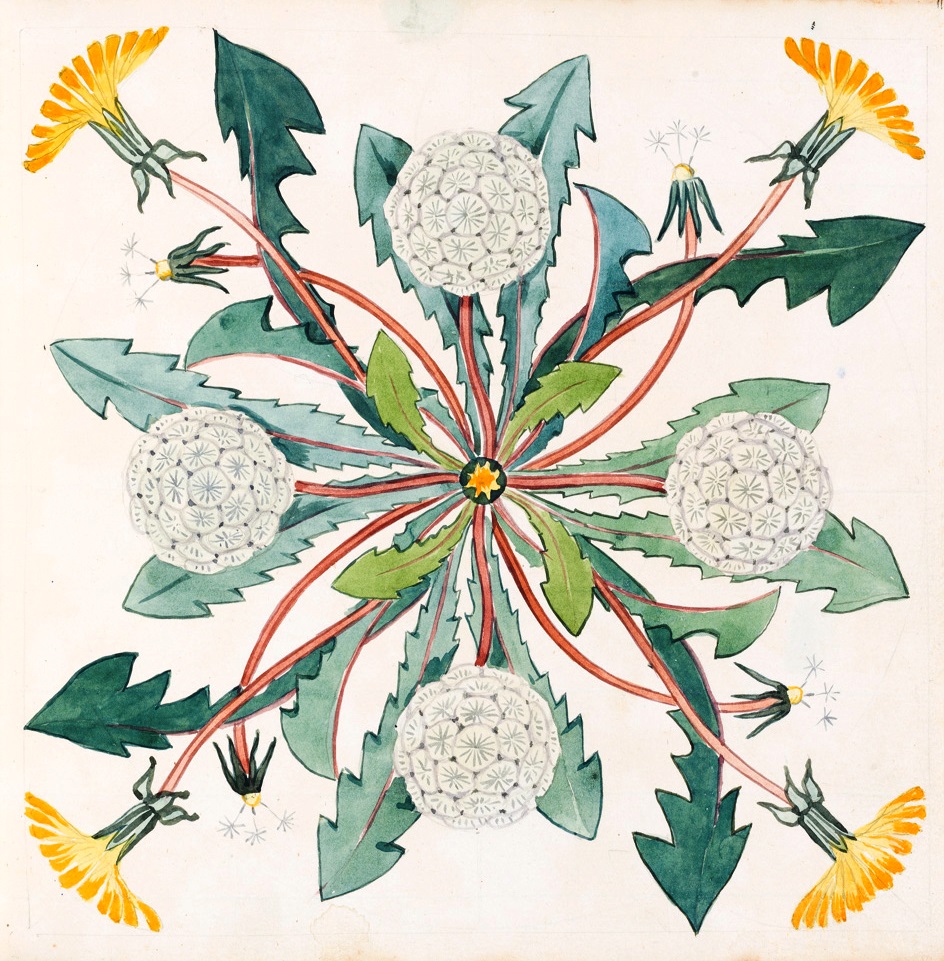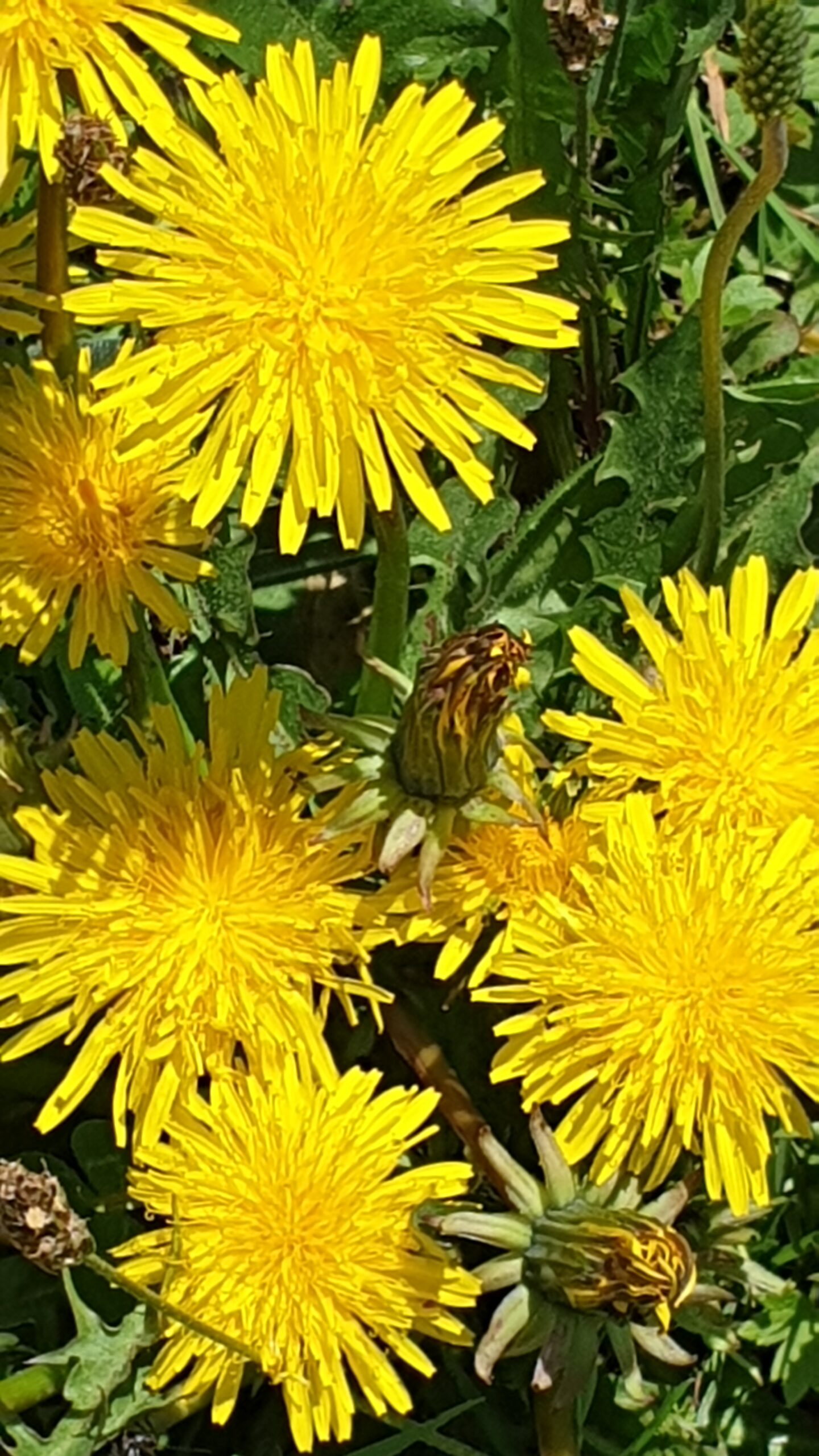
Clarence’s favourite flower, the humble Dandelion, in one of the vellum-bound albums by Clarence Bicknell in the Fitzwilliam Museum, Cambridge.
This image by Clarence Bicknell of the humble dandelion in a majestic arts-and-crafts pose is one of his most iconic. The symmetrical pattern is one of some 50 similar ones in one of the seven vellum-bound albums in the Fitzwilliam Museum, Cambridge University; so highly-rated and popular that they continue to be available in various styles of greetings cards (https://data.fitzmuseum.cam.ac.uk/id/agent/agent-157844 and for sale at https://curatingcambridge.co.uk/search?type=product&q=bicknell). The design features beautifully-drawn leaves, flowers and seed heads of four dandelions merging in the middle like the root stem in nature. Clarence honoured this perfect image on the humblest of plants, one which some gardeners and lawn-mowing-fanatics think of as a weed. No, it is a gift from God and from nature.
Clarence features the dandelion in other works, as related by Valerie Lester in MARVELS: The Life of Clarence Bicknell…
- “Clarence tried to tailor the subject matter of each bedroom to its occupant. For instance, the cook’s room was decorated with comestibles – a frieze of raspberries, gooseberries, strawberries, wild spinach, dandelion, caraway, monks’ rhubarb, chives and mushrooms!” MARVELS p.157
- “In 1911, to celebrate the coronation of King George V the previous year, he created a coronation procession of flowers. Another album, dated 1914, is an elaborate fantasy, The Triumph of the Dandelion, in which flowers compete to win The Order of the Golden Lion. Page by page each flower is illustrated presenting its claim in enchanting if somewhat sentimental prose and verse, and the common wild dandelion, rated by Clarence as his favourite flower, is the winner.” MARVELS p.165
Clarence would have known that the common name of Taraxacum Officinale is”dandelion” which is a corruption of the French “Dents de Lion” or “teeth of the lion” which refers to the shape of the leaves. An alternative French word for this plant is “pis-en-lit” or “piss in your bed” because the leaves are sometimes eaten in salads, but they are a diuretic, so they make you urinate more than normal!

Elisabetta Massardo writes “I have found that the obiquitous dandelion leaf is called king of the wild greens. A king that is found all over the world that is often eaten in salads or cooked as a vegetable. The leaves for salads should be picked when the plant is not yet in flower. Its root is used in medicine (especially good for liver complaints, as Clarence pointed out) and in the past even as a tea, coffee or wine substitute. It is considered diuretic, anti-rheumatic, laxative and heart-burn palliative. The dandelion is an important nectar and pollen plant for bees. The leaves and flowers are eaten by many kinds of animals including domestic sheep, cattle, sharp-tailed grouse, bighorn sheep, pocket gophers, deer, elk, grizzly and black bear, prairie chicken and sage grouse. What is called ‘soffione’ in Italian is connected with the end of the journey or the life. The seeds seem to represent the various stages of life to be faced fearlessly.”
Reginald Farrer thought of the dandelion as being at the bottom of the botanical pecking order and not worth looking after. He wrote “Strange stray women have gone about accusing me of ‘devastating’ regions and valleys of the Alps on which, in point of fact, I have never yet set foot. Come, come. On a given range a given species dwells. But that range is many miles long, incalculably vast and high, and the populating species can be calculated by the million and the many, many million. What a mighty void shall I then leave in even half a mile of slope if I pluck thence a hundred plants or so? The misconception of alarmists appears to be entirely based on the rooted inability of the public to realise the vastness of the mountains. In the Alps themselves, however, the misconception obtains, and I hug myself in derision whenever I see notices about the ‘Schutz der Edelweiss’. Why, almost every little mountain-hummock possesses whole lawns of it! We might just as well start a league for the protection of the Dandelion.”
Taraxacum Officinale. Family : Asteraceae. The dandelion is very common throughout mild climates of the northern hemisphere. It flowers in spring.